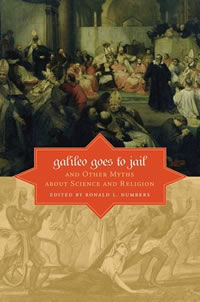Book Notes
 Ronald L. Numbers, editor, Galileo Goes to Jail and Other Myths About Science and Religion (Cambridge: Harvard University Press, 2009), 302pp.
Ronald L. Numbers, editor, Galileo Goes to Jail and Other Myths About Science and Religion (Cambridge: Harvard University Press, 2009), 302pp.
"The greatest myth in the history of science and religion," writes Ron Numbers, "holds that they have been in a state of constant conflict." By "myth" he means "a claim that is false." The twenty-five authors of this book each write a chapter to debunk one particular myth. About half of the authors are atheists or agnostics, five are mainline Protestants, two are evangelicals, one is Catholic, one Jewish, one Muslim, one Buddhist, and two hold "other" beliefs, so on the face of it there's no axe to grind here except for correcting the historical record.
The military metaphor used to describe the relationship between science and religion found its most polemical and influential expression in two books at the end of the nineteenth century: A History of the Warfare of Science with Theology in Christendom (1896) by Andrew Dickson White (the first president of Cornell University), and John William Draper's History of the Conflict between Religion and Science (1874). Both books excoriated religion for undermining scientific progress. Both were widely translated, are still in print today, and prime examples of myth mongering.
The conflict thesis holds sway in popular culture, the imagination of ordinary lay people, and on local school boards, but as the epigraphs that begin each chapter show, some of the most irresponsible myth makers are our best scientists — like Steven Weinberg repeating the trope that medieval Islamic culture was inhospitable to science (myth 4) or Stephen Gould insisting that creationsism is, thank God!, only "a local, indigenous American bizzarity" and not a global phenomenon (myth 24). But believers don't get a free pass, either; three chapters debunk myths that ostensibly support religion — that Christianity gave birth to modern science (myth 9), that evolution is based upon circular reasoning (myth 15), and that quantum physics demonstrates the truth of free will (myth 22).
Some of these powerful myths are not just wrong but convey the exact opposite of the truth, like the myth that Isaac Newton believed in a mechanistic or "clockwork" cosmology (myth 13). Others seem so obvious that you would think that they don't need rebuttal, like the idea that the Scopes trial spelled defeat for antievolution forces (myth 20) or that modern science has secularized society (myth 25). I especially appreciated the reminder that medieval Catholicism did not impede science but was "probably the largest single and longest term patron of science in history" (p. 102). The Jesuits were established in 1540, for example, and by 1625 they had founded 450 colleges across Europe (p. 104). A few of the essays feel like special pleading; it might be technically correct that Galileo was not tortured and imprisoned (myth 8), but reading about the Inquisition's gradations of torture was a depressing reminder of just how evil religion can become.
Believers might reflect on the wisdom of Saint Augustine. In his Literal Commentary on Genesis he lamented the ignorance of some Christians regarding the natural world, such as "the motion and orbit of the stars and even their size and relative positions, about the predictable eclipses of the sun and moon, the cycles of the years and seasons, about the kinds of animals, shrubs, stones, and so forth. . . Now it is a disgraceful and dangerous thing for an infidel [a non-Christian] to hear a Christian. . . talking nonsense on these topics; and we should take all means to prevent such an embarrassing situation, in which people show up vast ignorance in a Christian and laugh it to scorn" (p. 16). Reading this book is a good first step in following his advice.


